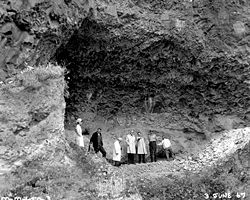Marmes Rockshelter
|
Marmes Rockshelter
|
|

Unknown officials in the Marmes Rock Shelter before it was submerged.
|
|
| Location | Franklin County, Washington, USA |
|---|---|
| Nearest city | Lyons Ferry, Washington |
| NRHP Reference # | 66000745 |
| Significant dates | |
| Added to NRHP | October 15, 1966 |
| Designated NHL | July 19, 1964 |
The Marmes Rockshelter (also known as (45-FR-50)) is an archaeological site first excavated in 1962, near the confluence of the Snake and Palouse Rivers, in Franklin County, southeastern Washington. This rockshelter is remarkable in the level of preservation of organic materials, the depth of stratified deposits, and the apparent age of the associated Native American human remains. The site was discovered on the property of Roland Marmes, and was the site of the oldest human remains in North America at that time. In 1966, the site became, along with Chinook Point and the American and English Camps on San Juan Island, the first National Historic Landmarks listed in Washington. In 1969, the site was submerged in water when a levee protecting it from waters rising behind the then newly constructed Lower Monumental Dam, which was 20 miles (32 km) down the Snake River, failed to hold back water that leaked into the protected area through gravel under the soil, creating Lake Herbert G. West.
The existence of the site was first brought to the attention of Professor Richard Daugherty in 1952 by a rancher named John McGregor. Excavations at the site were started by Daugherty and Roald Fryxell, a geologist, under the auspices of Washington State University (WSU)and the National Park Service in 1962, and continued until 1964. In 1965, Fryxell returned to the site along with Professor Carl Gustafson and students from WSU, and had Roland Marmes dig a trench in front of the rockshelter with his bulldozer, which turned up human and elk bones. Radiocarbon dating indicated that the human remains were about 10,000 years old. In 1968, Fryxell returned, this time with several WSU professors (including a visiting professor from Poland) and members of the United States Geological Survey, and found more human and animal remains, along with bone tools. April 29 of that year, Washington Senator Warren Magnuson made a public announcement of the finds.
...
Wikipedia

